雅思阅读heading题
雅思阅读-Heading题--大揭秘
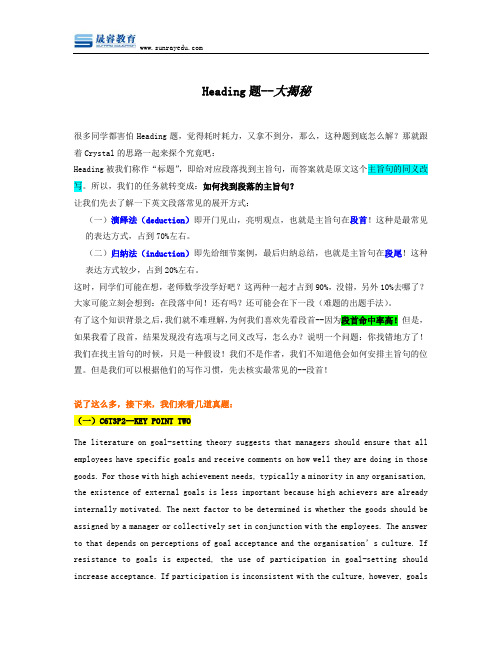
Heading题--大揭秘很多同学都害怕Heading题,觉得耗时耗力,又拿不到分,那么,这种题到底怎么解?那就跟着Crystal的思路一起来探个究竟吧:Heading被我们称作“标题”,即给对应段落找到主旨句,而答案就是原文这个主旨句的同义改写。
所以,我们的任务就转变成:如何找到段落的主旨句?让我们先去了解一下英文段落常见的展开方式:(一)演绎法(deduction)即开门见山,亮明观点,也就是主旨句在段首!这种是最常见的表达方式,占到70%左右。
(二)归纳法(induction)即先给细节案例,最后归纳总结,也就是主旨句在段尾!这种表达方式较少,占到20%左右。
这时,同学们可能在想,老师数学没学好吧?这两种一起才占到90%,没错,另外10%去哪了?大家可能立刻会想到:在段落中间!还有吗?还可能会在下一段(难题的出题手法)。
有了这个知识背景之后,我们就不难理解,为何我们喜欢先看段首--因为段首命中率高!但是,如果我看了段首,结果发现没有选项与之同义改写,怎么办?说明一个问题:你找错地方了!我们在找主旨句的时候,只是一种假设!我们不是作者,我们不知道他会如何安排主旨句的位置。
但是我们可以根据他们的写作习惯,先去核实最常见的--段首!说了这么多,接下来,我们来看几道真题:(一)C6T3P2--KEY POINT TWOThe literature on goal-setting theory suggests that managers should ensure that all employees have specific goals and receive comments on how well they are doing in those goods. For those with high achievement needs, typically a minority in any organisation, the existence of external goals is less important because high achievers are already internally motivated. The next factor to be determined is whether the goods should be assigned by a manager or collectively set in conjunction with the employees. The answer to that depends on perceptions of goal acceptance and the organisation’s culture. If resistance to goals is expected, the use of participation in goal-setting should increase acceptance. If participation is inconsistent with the culture, however, goalsshould be assigned. If participation and the culture are incongruous, employees are likely to perceive the participation process as manipulative and be negatively affected by it.这一段的主旨句在哪?有同学说,我看不懂段落结构,我不知道主旨句长什么样。
雅思阅读 Heading 2
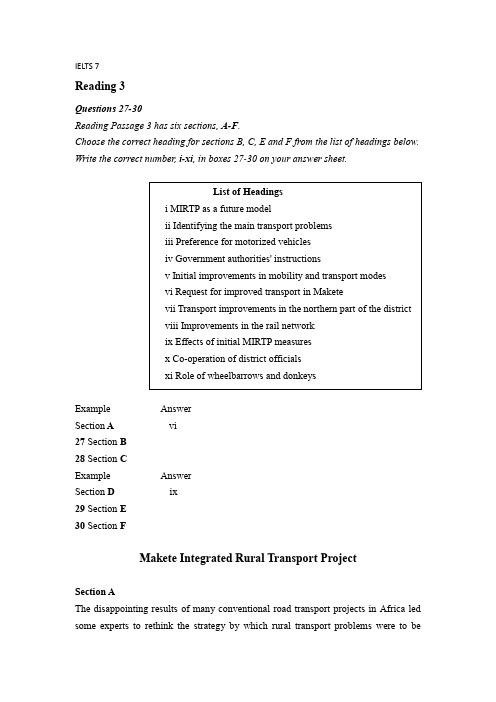
IELTS 7Reading 3Questions 27-30Reading Passage 3 has six sections, A-F.Choose the correct heading for sections B, C, E and F from the list of headings below. Write the correct number, i-xi, in boxes 27-30 on your answer sheet.Example AnswerSection A vi27 Section B28 Section CExample AnswerSection D ix29 Section E30 Section FMakete Integrated Rural Transport ProjectSection AThe disappointing results of many conventional road transport projects in Africa led some experts to rethink the strategy by which rural transport problems were to betackled at the beginning of the 1980s.A request for help in improving the availability of transport within the remote Makete District of south western Tanzania presented the opportunity to try a new approach.The concept of 'integrated rural transport' was adopted in the task of examining the transport needs of the rural households in the district. The objective was to reduce the time and effort needed to obtain access to essential goods and services through an improved rural transport system. The underlying assumption was that the time saved would be used instead for activities that would improve the social and economic development of the communities. The Makete Integrated Rural Transport Project (MIRTP) started in 1985 with financial support from the Swiss Development Corporation and was co-ordinated with the help of the Tanzanian government.Section BWhen the project began, Makete District was virtually totally isolated during the rainy season. The regional road was in such bad shape that access to the main towns was impossible for about three months of the year. Road traffic was extremely rare within the district, and alternative means of transport were restricted to donkeys in the north of the district. People relied primarily on the paths, which were slippery and dangerous during the rains.Before solutions could be proposed, the problems had to be understood. Little was known about the transport demands of the rural households, so Phase I, between December 1985 and December 1987, focused on research. The socio-economic survey of more than 400 households in the district indicated that a household in Makete spent, on average, seven hours a day on transporting themselves and their goods, a figure which seemed extreme, but which has also been obtained in surveys in other rural areas in Africa. Interesting facts regarding transport were found: 95% was on foot; 80% was within the locality: and 70% was related to the collection of water and firewood and travelling to grinding mills.Section CHaving determined the main transport needs, possible solutions were identified which might reduce the time and burden. During Phase II, from January to February 1991, anumber of approaches were implemented in an effort to improve mobility and access to transport.An improvement of the road network was considered necessary to ensure the import and export of goods to the district. These improvements were carried out using methods that were heavily dependent on labor. in addition to the improvement of roads, these methods provided training in the operation of a mechanical workshop and bus and truck services. However, the difference from the conventional approach was that this time consideration was given to local transport needs outside the road network.Most goods were transported along the paths that provide short-cuts up and down the hillsides, but the paths were a real safety risk and made the journey on foot even more arduous. It made sense to improve the paths by building steps, handrails and footbridges.It was uncommon to find means of transport that were more efficient than walking but less technologically advanced than motor vehicles. The use of bicycles was constrained by their high cost and the lack of available spare parts. Oxen were not used at all, but donkeys were used by a few households in the northern part of the district. MIRTP focused on what would be most appropriate for the inhabitants of Makete in terms of what was available, how much they could afford and what they were willing to accept. After careful consideration, the project chose the promotion of donkeys- a donkey costs less than a bicycle-and the introduction of a locally manufacturable wheelbarrow.Section DAt the end of Phase Il, it was clear that the selected approaches to Makete's transport problems had had different degrees of success.Phase Ill, from March 1991 to March 1993, focused on the refinement and institutionalization of these activities.The road improvements and accompanying maintenance system had helped make the district center accessible throughout the year.Essential goods from outside the district had become more readily available at the market, and prices did not fluctuate as muchas they had done before.Paths and secondary roads were improved only at the request of communities who were willing to participate in construction and maintenance.However, the improved paths impressed the inhabitants, and requests for assistance greatly increased soon after only a few improvements had been completed.The efforts to improve the efficiency of the existing transport services were not very successful because most of the motorized vehicles in the district broke down and there were no resources to repair them Even the introduction of low-cost means of transport was difficult because of the general poverty of the district.The locally manufactured wheelbarrows were still too expensive for all but a few of the households. Modifications, to the original design by local carpenters cut production time and costs.Other local carpenters have been trained in the new design so that they can respond to requests.Nevertheless, a locally produced wooden wheelbarrow which costs around 5000 Tanzanian shillings (less than US$20) in Makete and is about one quarter the cost of a metal wheelbarrow, is still too expensive for most people.Donkeys, which were imported to the district, have become more common and contribute, in particular to the transportation of crops and goods to market Those who have bought donkeys are mainly from richer households but with an increased supply through local breeding, donkeys should become more affordable.Meanwhile, local initiatives are promoting the renting out of the existing donkeys.It should be noted, however, that a donkey, which at 20,000 Tanzanian shillings costs less than a bicycle, is still an investment equal to an average household's income over half a year. This clearly illustrates the need for supplementary measures if one wants to assist the rural poor.Section EIt would have been easy to criticize the MIRTP for using in the early phases atop-down' approach, in which decisions were made by experts and officials before being handed down to communities, but it was necessary to start the process from the level of the governmental authorities of the district. It would have been difficult torespond to the requests of villagers and other rural inhabitants without the support and understanding of district authorities.Section FToday, nobody in the district argues about the importance of improved paths and inexpensive means of transport. But this is the result of dedicated work over a long period, particularly from the officers in charge of community development. They played an essential role in raising awareness and interest among the rural communities.The concept of integrated rural transport is now well established in Tanzania, where a major program of rural transport is just about to start. The experiences from Makete will help in this initiative, and Makete District will act as a reference for future work.Reading Passage 3, Questions 27-3027 ii28 v29 x30 i。
雅思阅读-heading题的做法
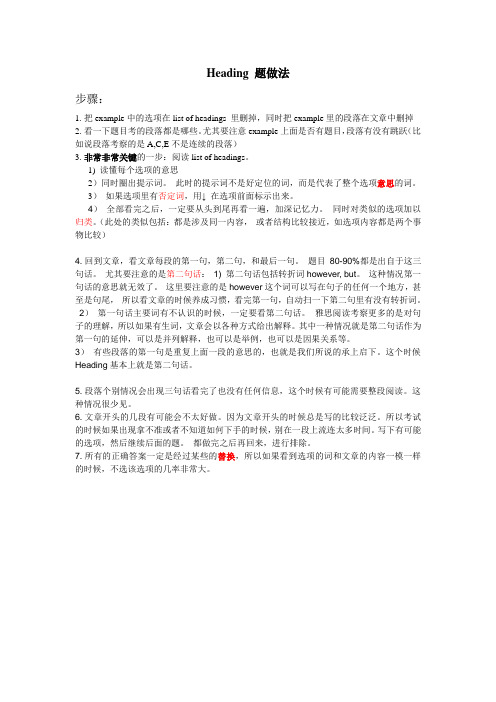
Heading 题做法步骤:1.把example中的选项在list of headings 里删掉,同时把example里的段落在文章中删掉2.看一下题目考的段落都是哪些。
尤其要注意example上面是否有题目,段落有没有跳跃(比如说段落考察的是A,C,E不是连续的段落)3.非常非常关键的一步:阅读list of headings。
1) 读懂每个选项的意思2)同时圈出提示词。
此时的提示词不是好定位的词,而是代表了整个选项意思的词。
3)如果选项里有否定词,用↓在选项前面标示出来。
4)全部看完之后,一定要从头到尾再看一遍,加深记忆力。
同时对类似的选项加以归类。
(此处的类似包括:都是涉及同一内容,或者结构比较接近,如选项内容都是两个事物比较)4. 回到文章,看文章每段的第一句,第二句,和最后一句。
题目80-90%都是出自于这三句话。
尤其要注意的是第二句话:1) 第二句话包括转折词however, but。
这种情况第一句话的意思就无效了。
这里要注意的是however这个词可以写在句子的任何一个地方,甚至是句尾,所以看文章的时候养成习惯,看完第一句,自动扫一下第二句里有没有转折词。
2)第一句话主要词有不认识的时候,一定要看第二句话。
雅思阅读考察更多的是对句子的理解,所以如果有生词,文章会以各种方式给出解释。
其中一种情况就是第二句话作为第一句的延伸,可以是并列解释,也可以是举例,也可以是因果关系等。
3)有些段落的第一句是重复上面一段的意思的,也就是我们所说的承上启下。
这个时候Heading基本上就是第二句话。
5. 段落个别情况会出现三句话看完了也没有任何信息,这个时候有可能需要整段阅读。
这种情况很少见。
6. 文章开头的几段有可能会不太好做。
因为文章开头的时候总是写的比较泛泛。
所以考试的时候如果出现拿不准或者不知道如何下手的时候,别在一段上流连太多时间。
写下有可能的选项,然后继续后面的题。
都做完之后再回来,进行排除。
雅思阅读heading题怎么解答
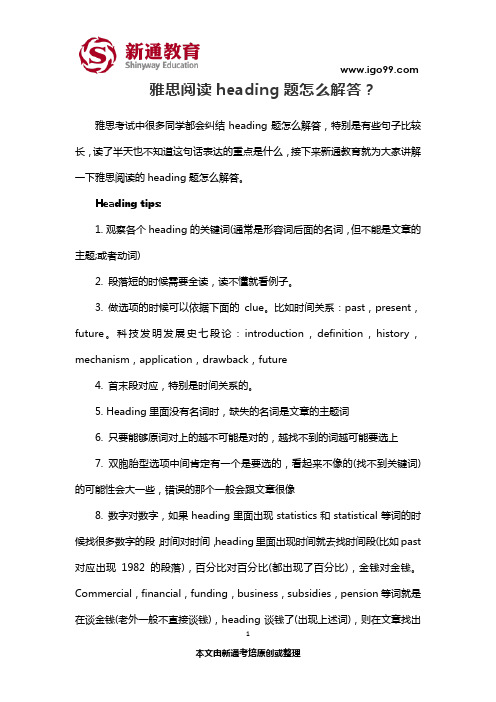
雅思阅读heading题怎么解答?雅思考试中很多同学都会纠结heading题怎么解答,特别是有些句子比较长,读了半天也不知道这句话表达的重点是什么,接下来新通教育就为大家讲解一下雅思阅读的heading题怎么解答。
Heading tips:1.观察各个heading的关键词(通常是形容词后面的名词,但不能是文章的主题;或者动词)2. 段落短的时候需要全读,读不懂就看例子。
3. 做选项的时候可以依据下面的clue。
比如时间关系:past,present,future。
科技发明发展史七段论:introduction,definition,history,mechanism,application,drawback,future4. 首末段对应,特别是时间关系的。
5. Heading里面没有名词时,缺失的名词是文章的主题词6. 只要能够原词对上的越不可能是对的,越找不到的词越可能要选上7. 双胞胎型选项中间肯定有一个是要选的,看起来不像的(找不到关键词)的可能性会大一些,错误的那个一般会跟文章很像8. 数字对数字,如果heading里面出现statistics和statistical等词的时候找很多数字的段,时间对时间,heading里面出现时间就去找时间段(比如past 对应出现1982的段落),百分比对百分比(都出现了百分比),金钱对金钱。
Commercial,financial,funding,business,subsidies,pension等词就是在谈金钱(老外一般不直接谈钱),heading谈钱了(出现上述词),则在文章找出1现金钱数字的段落。
(ps, multiple choice里面谈钱的选项一般可以直接去掉,因为老外不谈钱)以上就是雅思阅读heading题的解题技巧啦,相信大家以后看到这类题型的时候就会知道怎么解答了。
2。
雅思阅读9分之List_of_Headings题

雅思阅读9分之List of Headings题在自己多年的教学过程中见过无数的考生因雅思阅读中一些复杂的题型而挣扎,其中有T/F/NG题,List of Headings题,和Which paragraph contains the following information题等等。
在这里我想首先传达一个信息—万事万物都有捷径,都有方法,关键在于寻找。
就像初中解答平面几何时,一些看似无解的题目往往会在一道,两道辅助线的作用下使自己豁然开朗。
同样,雅思阅读中这些所谓的难题其实并不难,关键在于掌握正确的思路、方法。
这里我要启发大家思考,传授一种解答雅思阅读中List of Headings题的“2.0版本”的解法。
List of Headings题也叫做小标题题,顾名思义就是为文章中每个段落选择合适的能够概括段落大意的小标题来。
这种题型在雅思阅读考试中经常出现。
然而这种题型却往往因为解题方法的错误被误认为是难题。
其实,只要掌握正确的解题方法,该种题型一定会变得很简单并且可以全部做对。
大多数考生认为这种题型较难,因为他们采用了如下错误的解题思路:第一,大多数考生解答这种题型的思路在于寻找段落的中心句或主题句。
第二,他们还认为段落的中心句或主题句通常段落的首句,次句或尾句。
第三,根据判断出来的中心句或主题句确定正确选项。
但是,雅思阅读所有文章都有主题句或中心句吗?就算有主题句或中心句,它一定出现在首句,次句或尾句吗?答案是否定的。
所以,使用这种方法,考生常常常会有这样的经验:看完一个段落的首句发现刚好有一个标题与这句话对应,于是就把它选出来,但是这个选项偏偏是错误选项。
这样一来,考生做10道题就经常会做错其中的5-6道,而通常去蒙的话,也基本上能对4-5道,所以这种做题方法非常不可取,因为一旦判断错误主题句就一定会选错答案。
这是第一代的做题方法。
那么,我们应该如何避免错误判定主题句、中心句的尴尬或者干脆直接跳过主题句或中心句的判断呢?关键在于看动脑筋,积极思考,寻找出路—答案就是List of Headings题“第二代”,“2.0版本”的解题方法。
解决雅思阅读heading题的方法

解决雅思阅读heading题的方法解决雅思阅读heading题的方法在雅思阅读题型中,让同学们最为头痛的题型就是给段落找小标题的heading题。
因为雅思A类阅读文章涉及的题材非常学术化,例如生物学,历史文化,心理学等等,所以文章中一定会有许多跟专业学科有关系的生词,以至于对于很多学生来说,做题目并不是去理解文章的内容,而是找题目和文章中对应的关键字。
这种做法对于某些题型来说也许行的通,但是对于heading题来说,就不怎么管用了,因为Heading题是需要对于段落有一个整体把握,然后将内容归纳概括成几个词的小标题的,而且选择项又多于段落,会有一定的迷惑性,所以很有可能选错一个就连带错二到三个的可能。
所以现在很多同学看到heading题就会非常的慌张。
如果要做好heading题,除了平时要不断地扩展自己的词汇量以外,另一个基本功也是不可少的,因为考试时间是有限的.,不可能让大家真的像做阅读理解一样把文章的每一句都看懂都能翻译了再把内容归纳起来。
所以,雅思在这里为广大雅思考生介绍一个做heading 题的好帮手skimming。
Skimming,其实就是快速浏览的意思。
那一篇近1000字的英语文章要浏览哪些内容呢?其实很简单,首先是看那些比较显眼的东西,例如大标题,小标题,数字,粗体字和斜体字等等,这样会对接下来做题目定位有一定的帮助。
其次是看首段以及每一段的第一句话,因为第一段是整篇文章的开始,由于学术类文章的特性,很少会有像散文那样先铺垫个一大堆酝酿一下情绪再把中心描述出来,一般雅思A 类阅读文章都是比较开门见山,第一段就会告诉我们整篇文章在讲什么,可能会从哪些方面来阐述。
而其他段落的第一句也是比较重要的,要让看的人知道作者想要表达的中心,每段的第一句话就是最好地位置去说明且让人印象深刻的。
雅思阅读-小标题_list_of_heading

1) A steel wall has better insulating properties.
2) Steel wall panels save time and labor.
3) A steel wall conserves floor space.
Some Shortcuts
主题句一定是包含性最强的句子 1. 例句不是主题句 2. 问句不是主题句 3. 从句不是主题句 4. 明显包含细节的句子不是主题句 5. however 出现后看后半句 6. sb believe/hold/ imply 等引导的宾从是主句 7. In spite of/despite, 看后半句 8. 平行关系的段落没有主题句
LECTURE THREE 小标题
First things first
基础较好,List of heading 则一般先做 List of heading 题出现在文章前,要特
别注意不要漏做 在真实考试中,每个标题只用一次 例子中已经选过的段落可以直接去掉 注意不要写串答案
3 possibilities
Follow the following procedure
List of Headings The 1st, 2nd &
the Last Sentences Topic Sentence
Main Idea
Most suitable Heading
III 主题句与支持句练习
In a growing number of hotels and skyscrapers across the nation, steel walls have replaced the foot-thick brick and mortar walls once used. Tests show that a steel wall four inches thick has better insulating qualities than a 12-inch thickness of masonry. In addition, steel-curtain wall panels save both time and labor. And the floor space conserves red by use of the thin wall as against the thick wall in a big office building can mean a couple of hundred dollars a year in rentals.
雅思阅读heading题技巧

例16
• For many courses in the University, the majority of your marks will be based on your written work. It is essential that you develop your skills as a writer for the different subjects in which you study. Most departments offer advice and guidelines on how to present your written assignments but you should be aware
• An intellectual breakthrough, brilliant though it may be, does not automatically ensure that the transition is made from theory to practice.Despite the fact that rockets had been used sporadically for several hundred years, they remained a relatively minor artefact of civilisation until the twentieth century.…
And they help… For example, their…
例17
Your student card, obtained on completion of enrolment, is proof that you are enrolled. Please take special care of it and carry it with you when you’re at the university. You may be asked to show it to staff at any time. This card is also your discount card and access card for the Students’ Union as well as allowing your access to the library. • student card
雅思阅读难题解读:headings
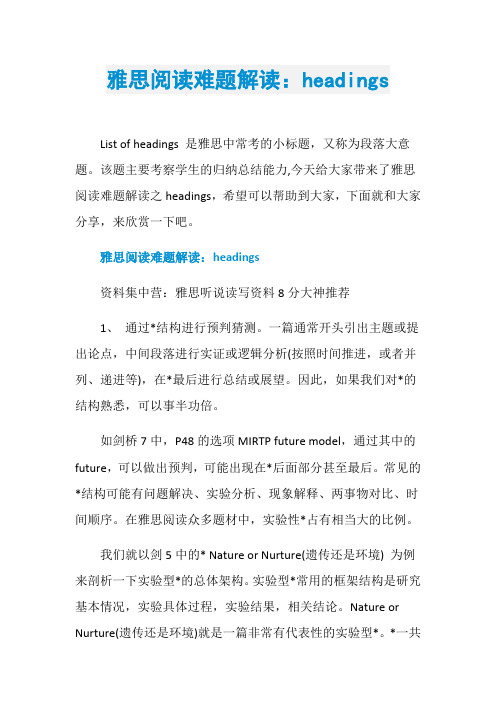
雅思阅读难题解读:headingsList of headings 是雅思中常考的小标题,又称为段落大意题。
该题主要考察学生的归纳总结能力,今天给大家带来了雅思阅读难题解读之headings,希望可以帮助到大家,下面就和大家分享,来欣赏一下吧。
雅思阅读难题解读:headings资料集中营:雅思听说读写资料8分大神推荐1、通过*结构进行预判猜测。
一篇通常开头引出主题或提出论点,中间段落进行实证或逻辑分析(按照时间推进,或者并列、递进等),在*最后进行总结或展望。
因此,如果我们对*的结构熟悉,可以事半功倍。
如剑桥7中,P48的选项MIRTP future model,通过其中的future,可以做出预判,可能出现在*后面部分甚至最后。
常见的*结构可能有问题解决、实验分析、现象解释、两事物对比、时间顺序。
在雅思阅读众多题材中,实验性*占有相当大的比例。
我们就以剑5中的* Nature or Nurture(遗传还是环境) 为例来剖析一下实验型*的总体架构。
实验型*常用的框架结构是研究基本情况,实验具体过程,实验结果,相关结论。
Nature or Nurture(遗传还是环境)就是一篇非常有代表性的实验型*。
*一共分为9 段,框架结构非常清晰。
*一开始就总体上介绍了实验的参与者是40个来自各个行业的教师- 实验对象。
接下来阐述了实验的背景设置和学生参与者的真实身份。
*的第三段则是比较详细地介绍了在实验过程中实验对象和实验者Milgram 的表现。
第四段和第五段分别呈现了精神科医生对实验结果的预测和实际实验结果与预测结果形成的巨大反差。
精神科医生预测,只有少数的教师实验对象能按照实验者的要求,把电压加到最大值。
而实验的实际结果就是85% 的教师实验对象都做到了这一点。
第六、七段是从遗传和环境的角度用两种截然不同的说法来解释这些差异。
最后两段则是从当代社会生物学角度总结了这个实验的结论。
再比如,在剑桥9 attitudes to language一文中,作者采用的方法就是两种语言态度的对比,一个是prescribe,另外一个则是describe。
7 雅思基础阅读 List of heading
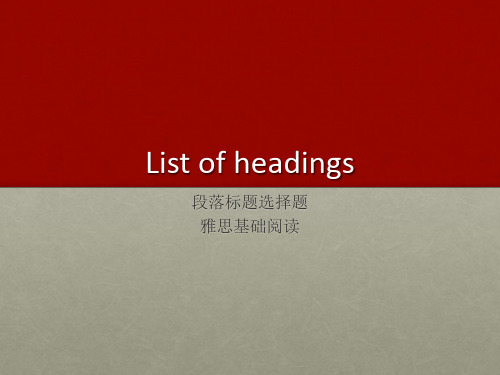
• C8 T1 P2 P22 C8 T2 P2 P45 C8 T2 P3 P49 C8 T3 P3 P74 C8 T4 P1 P88
• C9 T1 P2 P21 C9 T4 P3 P96
See you!
List of headings
段落标题选择题 雅思基础阅读
list of headings
段落标题选择题
段落标题选择题
1)题目位于文章 之前 2)选项以短语形 式出现,选项数量 多于段落数量,呈 乱序排列 3)选项不可能重 复使用
1)看文章标题
2)将例子所在的选项划去,同 时不用理会例子所在的段落
3)画出剩下选项的关键词
4)回归标题选项,再看一遍画 出的关键词,形成暂时记忆
5)略读文章的每一段话,寻找 主题句和核心词汇
6)某段话的答案确定后,将它 的选项从选项列表中划去
1)看文章标题
2)将例子所在的选项划去,同 时不用理会例子所在的段落
3)画出剩下选项的关键词
4)回归标题选项,再看一遍画 出的关键词,形成暂时记忆
3)画出剩下选项的关键词
4)回归标题选项,再看一遍画出的 关键词,形成暂时记忆
5)略读文章的每一段话,寻找主题 句和核心词汇
6)某段话的答案确定后,将它的选 项从选项列ist of headings) C4 T4 P3 P96
• C6 T1 P3 P26 C6 T2 P1 P40 C6 T3 P2 P67 C6 T4 P1 P85 C6 T4 P3 P93
5)略读文章的每一段话,寻找 主题句和核心词汇
6)某段话的答案确定后,将它 的选项从选项列表中划去
2019-雅思阅读标题(Heading)全面解析-优秀word范文 (1页)
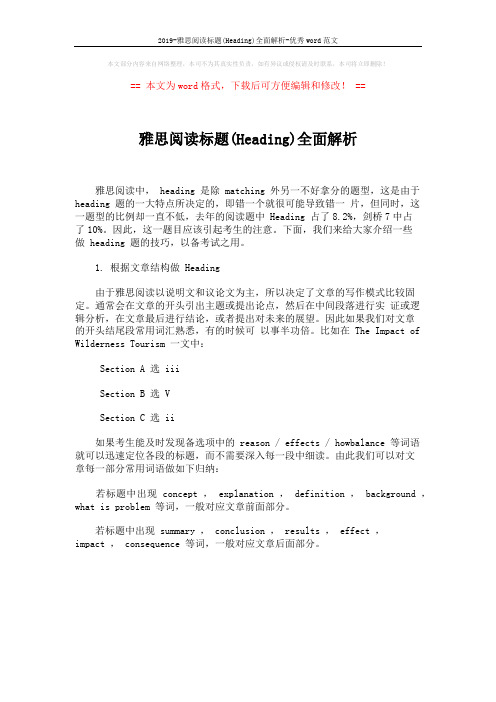
2019-雅思阅读标题(Heading)全面解析-优秀word范文本文部分内容来自网络整理,本司不为其真实性负责,如有异议或侵权请及时联系,本司将立即删除!== 本文为word格式,下载后可方便编辑和修改! ==雅思阅读标题(Heading)全面解析雅思阅读中, heading 是除 matching 外另一不好拿分的题型,这是由于heading 题的一大特点所决定的,即错一个就很可能导致错一片,但同时,这一题型的比例却一直不低,去年的阅读题中 Heading 占了8.2%,剑桥7中占了10%。
因此,这一题目应该引起考生的注意。
下面,我们来给大家介绍一些做 heading 题的技巧,以备考试之用。
1. 根据文章结构做 Heading由于雅思阅读以说明文和议论文为主,所以决定了文章的写作模式比较固定。
通常会在文章的开头引出主题或提出论点,然后在中间段落进行实证或逻辑分析,在文章最后进行结论,或者提出对未来的展望。
因此如果我们对文章的开头结尾段常用词汇熟悉,有的时候可以事半功倍。
比如在 The Impact of Wilderness Tourism 一文中:Section A 选 iiiSection B 选 VSection C 选 ii如果考生能及时发现备选项中的 reason / effects / howbalance 等词语就可以迅速定位各段的标题,而不需要深入每一段中细读。
由此我们可以对文章每一部分常用词语做如下归纳:若标题中出现 concept , explanation , definition , background ,what is problem 等词,一般对应文章前面部分。
若标题中出现 summary , conclusion , results , effect ,impact , consequence 等词,一般对应文章后面部分。
2019-2020-雅思阅读Headings题的三大解题重点-优秀word范文 (1页)
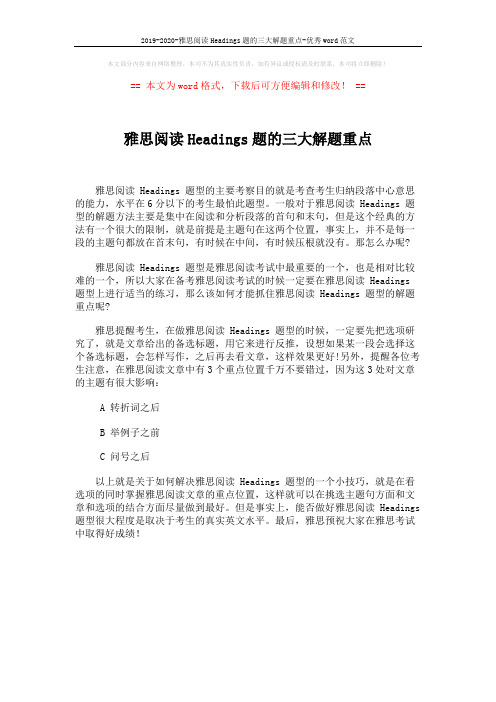
2019-2020-雅思阅读Headings题的三大解题重点-优秀word范文本文部分内容来自网络整理,本司不为其真实性负责,如有异议或侵权请及时联系,本司将立即删除!== 本文为word格式,下载后可方便编辑和修改! ==雅思阅读Headings题的三大解题重点雅思阅读 Headings 题型的主要考察目的就是考查考生归纳段落中心意思的能力,水平在6分以下的考生最怕此题型。
一般对于雅思阅读 Headings 题型的解题方法主要是集中在阅读和分析段落的首句和末句,但是这个经典的方法有一个很大的限制,就是前提是主题句在这两个位置,事实上,并不是每一段的主题句都放在首末句,有时候在中间,有时候压根就没有。
那怎么办呢?雅思阅读 Headings 题型是雅思阅读考试中最重要的一个,也是相对比较难的一个,所以大家在备考雅思阅读考试的时候一定要在雅思阅读 Headings 题型上进行适当的练习,那么该如何才能抓住雅思阅读 Headings 题型的解题重点呢?雅思提醒考生,在做雅思阅读 Headings 题型的时候,一定要先把选项研究了,就是文章给出的备选标题,用它来进行反推,设想如果某一段会选择这个备选标题,会怎样写作,之后再去看文章,这样效果更好!另外,提醒各位考生注意,在雅思阅读文章中有3个重点位置千万不要错过,因为这3处对文章的主题有很大影响:A 转折词之后B 举例子之前C 问号之后以上就是关于如何解决雅思阅读 Headings 题型的一个小技巧,就是在看选项的同时掌握雅思阅读文章的重点位置,这样就可以在挑选主题句方面和文章和选项的结合方面尽量做到最好。
但是事实上,能否做好雅思阅读 Headings 题型很大程度是取决于考生的真实英文水平。
最后,雅思预祝大家在雅思考试中取得好成绩!。
【2019-2020】雅思阅读题型:Heading题答题方法-推荐word版 (1页)
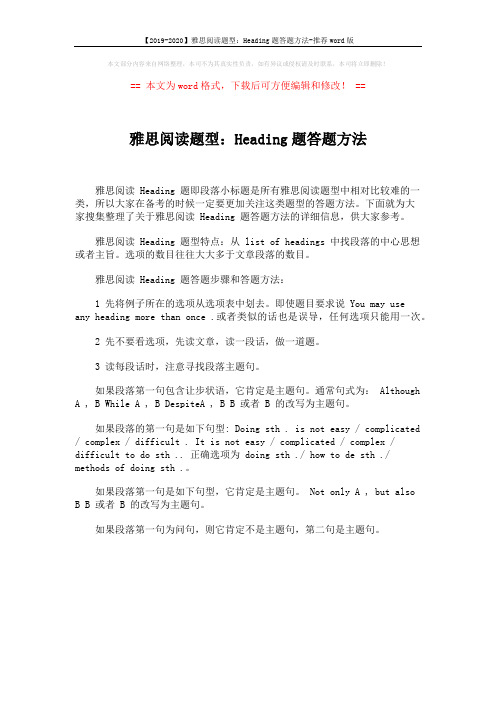
【2019-2020】雅思阅读题型:Heading题答题方法-推荐word版本文部分内容来自网络整理,本司不为其真实性负责,如有异议或侵权请及时联系,本司将立即删除!== 本文为word格式,下载后可方便编辑和修改! ==雅思阅读题型:Heading题答题方法雅思阅读 Heading 题即段落小标题是所有雅思阅读题型中相对比较难的一类,所以大家在备考的时候一定要更加关注这类题型的答题方法。
下面就为大家搜集整理了关于雅思阅读 Heading 题答题方法的详细信息,供大家参考。
雅思阅读 Heading 题型特点:从 list of headings 中找段落的中心思想或者主旨。
选项的数目往往大大多于文章段落的数目。
雅思阅读 Heading 题答题步骤和答题方法:1 先将例子所在的选项从选项表中划去。
即使题目要求说 You may useany heading more than once .或者类似的话也是误导,任何选项只能用一次。
2 先不要看选项,先读文章,读一段话,做一道题。
3 读每段话时,注意寻找段落主题句。
如果段落第一句包含让步状语,它肯定是主题句。
通常句式为: Although A , B While A , B DespiteA , B B 或者 B 的改写为主题句。
如果段落的第一句是如下句型: Doing sth . is not easy / complicated / complex / difficult . It is not easy / complicated / complex / difficult to do sth .. 正确选项为 doing sth ./ how to de sth ./ methods of doing sth .。
如果段落第一句是如下句型,它肯定是主题句。
Not only A , but alsoB B 或者 B 的改写为主题句。
如果段落第一句为问句,则它肯定不是主题句,第二句是主题句。
雅思阅读9分之List of Headings题
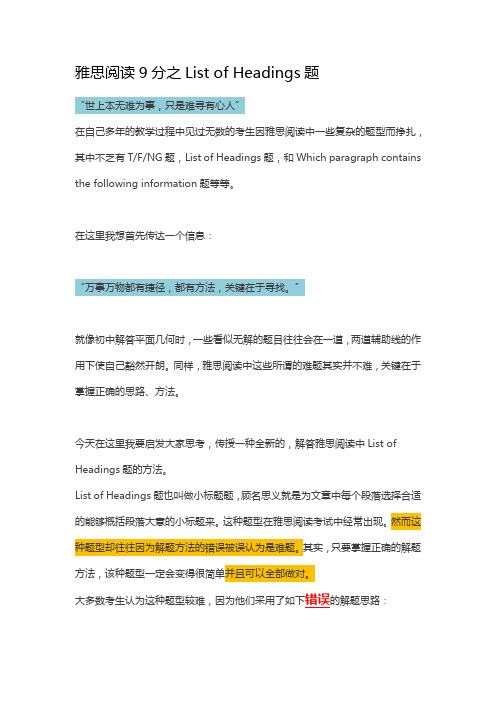
雅思阅读9分之List of Headings题“世上本无难为事,只是难寻有心人”在自己多年的教学过程中见过无数的考生因雅思阅读中一些复杂的题型而挣扎,其中不乏有T/F/NG题,List of Headings题,和Which paragraph contains the following information题等等。
在这里我想首先传达一个信息:“万事万物都有捷径,都有方法,关键在于寻找。
”就像初中解答平面几何时,一些看似无解的题目往往会在一道,两道辅助线的作用下使自己豁然开朗。
同样,雅思阅读中这些所谓的难题其实并不难,关键在于掌握正确的思路、方法。
今天在这里我要启发大家思考,传授一种全新的,解答雅思阅读中List of Headings题的方法。
List of Headings题也叫做小标题题,顾名思义就是为文章中每个段落选择合适的能够概括段落大意的小标题来。
这种题型在雅思阅读考试中经常出现。
然而这种题型却往往因为解题方法的错误被误认为是难题。
其实,只要掌握正确的解题方法,该种题型一定会变得很简单并且可以全部做对。
大多数考生认为这种题型较难,因为他们采用了如下错误的解题思路:第一,大多数考生解答这种题型的思路在于寻找段落的中心句或主题句。
第二,他们还认为段落的中心句或主题句通常段落的首句,次句或尾句。
第三,根据判断出来的中心句或主题句确定正确选项。
但是,雅思阅读所有文章都有主题句或中心句吗?就算有主题句或中心句,它一定出现在首句,次句或尾句吗?答案是否定的。
所以,使用这种方法,考生常常会有这样的经验:看完一个段落的首句发现刚好有一个标题与这句话对应,于是就把它选出来,但是这个选项偏偏是错误选项。
这样一来,考生做10道题就经常会做错其中的5-6道,而通常去蒙的话,也基本上能对4-5道,所以这种做题方法非常不可取,因为一旦判断错误主题句就一定会选错答案。
这是第一代的做题方法。
在现今的时代背景下可以说是错误的!那么,我们应该如何避免错误判定主题句、中心句的尴尬或者干脆直接跳过主题句或中心句的判断呢?关键在于开动脑筋,积极思考,寻找出路——答案就是List of Headings题“第二代”,“2.0版本”的解题方法。
- 1、下载文档前请自行甄别文档内容的完整性,平台不提供额外的编辑、内容补充、找答案等附加服务。
- 2、"仅部分预览"的文档,不可在线预览部分如存在完整性等问题,可反馈申请退款(可完整预览的文档不适用该条件!)。
- 3、如文档侵犯您的权益,请联系客服反馈,我们会尽快为您处理(人工客服工作时间:9:00-18:30)。
Skimming! The first sentence of the paragraph
The second sentence of the paragraph The last part of the paragraph
4.
You also need to pay attention to these words:
C7 (P20, P22, P46, P48, P69)
Thank you !
eg: in addition/moreover/furthermore/
but/however/thus/therefore
TIPS:
TIME RULES
补充说明
Future things come last.
Hale Waihona Puke Contend related to the past should be talked about firstly
IELTS
8:30 enter the examination room 9:00-9:30 listening 9:40-10:40 reading 10:40-11:40 writing (2) 10 mins oral test 1 vs 1 10 mins transcript
READING
Pay attention to the synonyms
eg: define/definition/refer to as/be viewed as/be called/be considered as/known as/be labeled as
Rules in finding Topic Sentence
•4. One paragraph only has one heading, but the numbers of headings are always more than the number of paragraphs.
Steps of doing List of Headings
Pay attention to the title
IELTS
READING
刘 璐
How do you feel?
IELTS
IELTS is the International English Language Testing System, the world’s proven English language test.
IELTS was one of the pioneers of four skills English language testing over 25 years ago, and continues to set the standard for English language testing today.
Academic or General Training 60 mins 3 passages 3000 or more words 40 questions
READING
List of headings True/ False/ NOT Given
Summary
Multiple-choice Matching Short Answer Questions Flow Charts
Eg: Early, previous, used, former, Past, earlier, model…
Eg: Future, long-term prospects, predict…
Practice
C8 P112 Snake Oil
28 Section C ⅴ 29 Section D ⅶ 30 Section E ⅸ
31 Section F ⅹ
32 Section G ⅲ
33 Section H ⅳ
Time for your turn
C3 (P14, P23, P42, P64) C5 (P22, P64, P66, P73, P85) C6 (P20, P26, P40, P65, P67, P85, P93)
Cross out the examples in the questions Find the key words in the list Determine the topic sentences of each paragraph
Key Words
Rules of finding key words KWs are related to the topic nouns>verbs>adjectives
Sentence Completion
List of headings
Characteristics
•1. It always appears at the beginning of IELTS READING exam;
•2. The options in the question normally appear as phrases. These options are usually not in an order; •3. Some questions have examples which can be eliminated when doing the exam;
